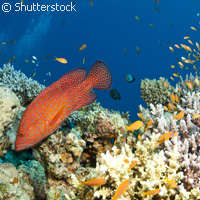Another milestone for marine science's greatest endeavour
As the largest ever collaboration in marine biology history, research under the Census of Marine Life initiative, funded in part by the EU, has resulted in the discovery of at least 1,200 new species, and generated more than 2,600 publications. The latest in a long list of achievements is a species inventory of distribution and diversity in 25 key ocean areas. The inventory is part of a collection of articles published in PLoS (Public Library of Science) ONE. Support for the work came from two projects funded under the EU's Seventh Framework Programme (FP7): ECOFUN ('Analysis of biodiversity changes on structural and functional properties of marine ecosystems under cumulative human stressors'), backed with more than EUR 212,000 from the People specific programme; and HERMIONE ('Hotspot ecosystem research and man's impact on European seas') with EUR 8 million from the Environment Theme. Between 2000 and 2010, more than 2,700 scientists from over 80 countries contributed to some 538 marine expeditions under Census of Marine Life. The inventory represents a remarkable combination of research findings from the last 10 years but also information that has been in the public domain for centuries. It is a historic roll call of species from 25 key biologically representative regions on Earth that will help set a baseline for measuring future changes. Dr Patricia Miloslavich, senior scientist of the Census of Marine Life and leader of the regional studies, said: 'To create this baseline, the Census of Marine Life explored new areas and ecosystems, discovering new species and records of species in new places.' The total number of species in the 25 areas ranges from 2,600 to 33,000. Crustaceans top the inventory list, comprising about one fifth of all species, while only 2% of the species comprise whales, sea lions, seals, turtles and other vertebrates. But for every known species, the Census of Marine Life scientists believe that more than four new species are still waiting to be discovered. In their paper, the authors explain that although scientists have discovered almost 2 million species and that great knowledge gains have been made, 'this knowledge may distract attention from the estimated four fifths of species on Earth that remain unknown to science, many of them inhabiting our oceans'. The lead author of the collection summary, Dr Mark Costello, explained there were two reasons why the inventory was so urgent. The first is due to our impaired ability to discover and describe new species because of dwindling expertise in taxonomy. The second is due to the major declines in the numbers of marine species as a result of human activities. In fact, human-related activities, such as overfishing and pollution, have been identified in Census of Marine Life studies as among the main threats to marine life. Emerging threats to marine life include water temperature increases and acidification of sea water. Dr Miloslavich added that there is a sense of urgency to increase our knowledge of unknown biodiversity, 'before much of it is lost without even being discovered'. 'The Census has made a tremendous contribution by bringing order to chaos. This previously scattered information is now all reviewed, analysed and presented in a collection of papers at an open access journal,' concluded Dr Miloslavich. The inventory's 25 ocean areas include Alaska (US), Antarctica, Atlantic Europe, Australia, Baltic, Brazil shelves, Canada Arctic, Canada Eastern, Canada Western, Caribbean, China, Gulf of Mexico, Hawaii, Humboldt Current, Japan, Mediterranean, New Zealand, Patagonian Shelf, South America Tropical West Atlantic, South Africa, South Korea, Tropical East Pacific, US California, Northeast US, and Southeast US. The PLoS ONE landmark collection of papers was compiled by 13 committees and over 360 scientists. The papers are available to any interest member of the public.



